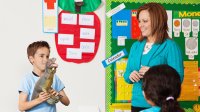10 Books That Model SEL Problem-Solving
These picture books demonstrate social and emotional learning skills as the characters participate in show-and-tell.
Your content has been saved!
Go to My Saved Content.As a kindergarten teacher, I struggled and strategized how to successfully conduct show-and-tell so that busy bodies and minds (including mine) could pay attention to peer presentations. I found my ultimate fix when I relegated show-and-tell to the role of “dinner theater.”
Students did presentations during lunch (snack time would work as well), and I quickly discovered that having everyone seated at tables, with their hands and mouths occupied during each presentation, helped with listening, processing, and formulating questions and comments.
Show-and-tell has been a feature of early childhood programs for decades. Originally considered to be a foundational activity for public speaking, it’s also a classroom community-building activity with great benefits for social and emotional learning (SEL). In a thoughtfully designed show-and-tell program, students can work on at least four CASEL social and emotional goals in two SEL domains: self-awareness and social awareness.
For a presenter, regarding self-awareness, show-and-tell can assist with integrating personal and social identity and with developing interests and a sense of purpose.
For an audience member, relating to social awareness, show-and-tell can assist with recognizing strengths in others and showing concern for the feelings of others.
The following picture books feature unique characters who share items and their interests with others. These titles can assist families, teachers, and students with SEL discussions about show-and-tell in a familiar read-aloud setting. Each title offers a unique way of viewing show-and-tell, and reading numerous titles allows everyone to consider a variety of scenarios associated with sharing parts of yourself with others as well as strategies for being an empathetic listener.
10 Picture books That Promote SEL
Clem and Crab, by Fiona Lumbers. While searching for treasures and trash on the beach, Clem discovers a crab. Crab hitches a ride back to Clem’s house and ultimately becomes part of Clem’s school show-and-tell presentation. Clem and Crab’s story ultimately inspires her classmates to action to help clean the beach for Crab. Corresponding coloring pages are available on the publisher’s Free Stuff page. Author-illustrator Fiona Lumbers reads her book in a Waterstones video. (Preschool–grade 3)
Daniel Tiger’s Neighborhood: Show and Tell Day! Adapted by Alexandra Cassel Schwartz, illustrated by Jason Fruchter. Daniel Tiger can’t find a toy from home to bring to show-and-tell, so he decides to make something instead. Daniel transforms a shoebox, a small blanket, and a sock ball into a bed for his stuffed animal Tigey. (Preschool–grade 2)
John’s Turn, by Mac Barnett, illustrated by Kate Berube. This book is written from the collective student audience point of view. Young Matthew is apprehensive prior to the “Sharing Gifts” assembly, but he gathers his courage and performs a dance in front of the entire school. At the end of the performance, all of the students give Matthew a standing ovation. A corresponding teacher’s guide is available on the publisher’s website. Author Mac Barnett shares his inspiration for this book in a Candlewick video. (Preschool–grade 3)
Mr. Putter & Tabby Ring the Bell, by Cynthia Rylant, illustrated by Arthur Howard. Mr. Putter and his neighbor Mrs. Teaberry are young in spirit but old in years. They head back to first grade for a special show-and-tell presentation featuring Mr. Putter’s cat Tabby and Mrs. Teaberry’s dog Zeke. If this sounds like a terrible idea, you are right! (Kindergarten–grade 3)
My Heart Is a Compass, by Deborah Marcero. Rose wants to bring “something that had never been found” for show-and-tell. Using her imagination, Rose crisscrosses the universe guided by maps that she makes to seek out a unique object. Ultimately, she presents her maps and shares her journey at show-and-tell, which ultimately inspires her classmates to make their own maps. (Preschool–grade 3)
Our Favorite Day of the Year, by A. E. Ali, illustrated by Rahele Jomepour Bell. On the first day of kindergarten, Ms. Gupta tells her class that during show-and-tell, each student will select their favorite day to share. “That way, the class will celebrate it with you!” The class learns about and celebrates such holidays as Eid al-Fitr, Rosh Hashanah, Las Posadas, and Pi Day. (Preschool–grade 3)
Pete the Cat: Show-and-Tell, by James Dean and Kimberly Dean, illustrated by James Dean. Pete brings his cool baseball mitt to school for show-and-tell. The mitt has been passed down through Pete’s family, and he loves to use it to play catch with his dad. At school, Pete compares his old, but much loved, mitt with the other objects that his classmates have brought in. Is his mitt cool enough? (Preschool–grade 2)
Show and Tell, by Rob Biddulph. Welcome to the most outrageous classroom “bring and brag” scenario ever. Twenty-six second graders compete for the most impressive show-and-tell object judged by their teacher. In this out-of-this-world tale, each student tries to outdo the previous classmate, and items range from a sunflower seed to Big Ben. (Kindergarten–grade 3)
The Show-and-Tell Lion, by Barbara Abercrombie, illustrated by Lynne Avril. At show-and-tell, Matthew blurts out that he has a baby lion named Larry. After fielding numerous questions from curious classmates, Matthew finds himself way in over his head. He shares his problem with his mother, who affirms his wonderful imagination but advises that he should reveal the truth. While his classmates are disappointed, Matthew pivots to sharing a book he has written about Larry’s adventures, which is an exciting show-and-tell. (Preschool–grade 2)
Threads of Me: Kente for Show and Tell, by Erica Asante, illustrated by Chengetai Lerato Masalethulini. Ama’s show-and-tell assignment is to bring in an object that represents her heritage. Ama consults with her grandmother, who tells her the traditional story of Ghana’s kente cloth and suggests bringing in kente that has been passed down through the generations in Ama’s family. (Kindergarten–grade 2)
